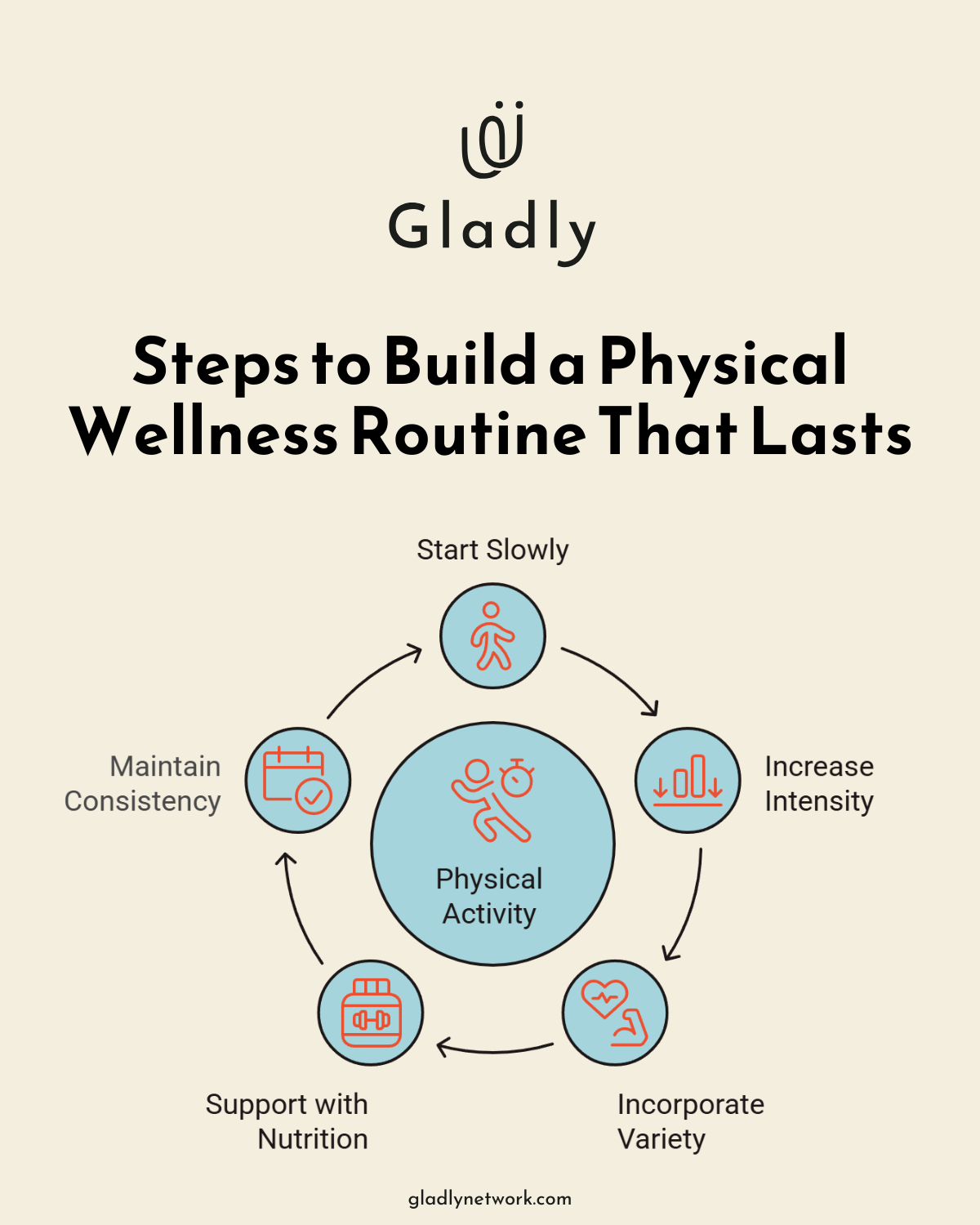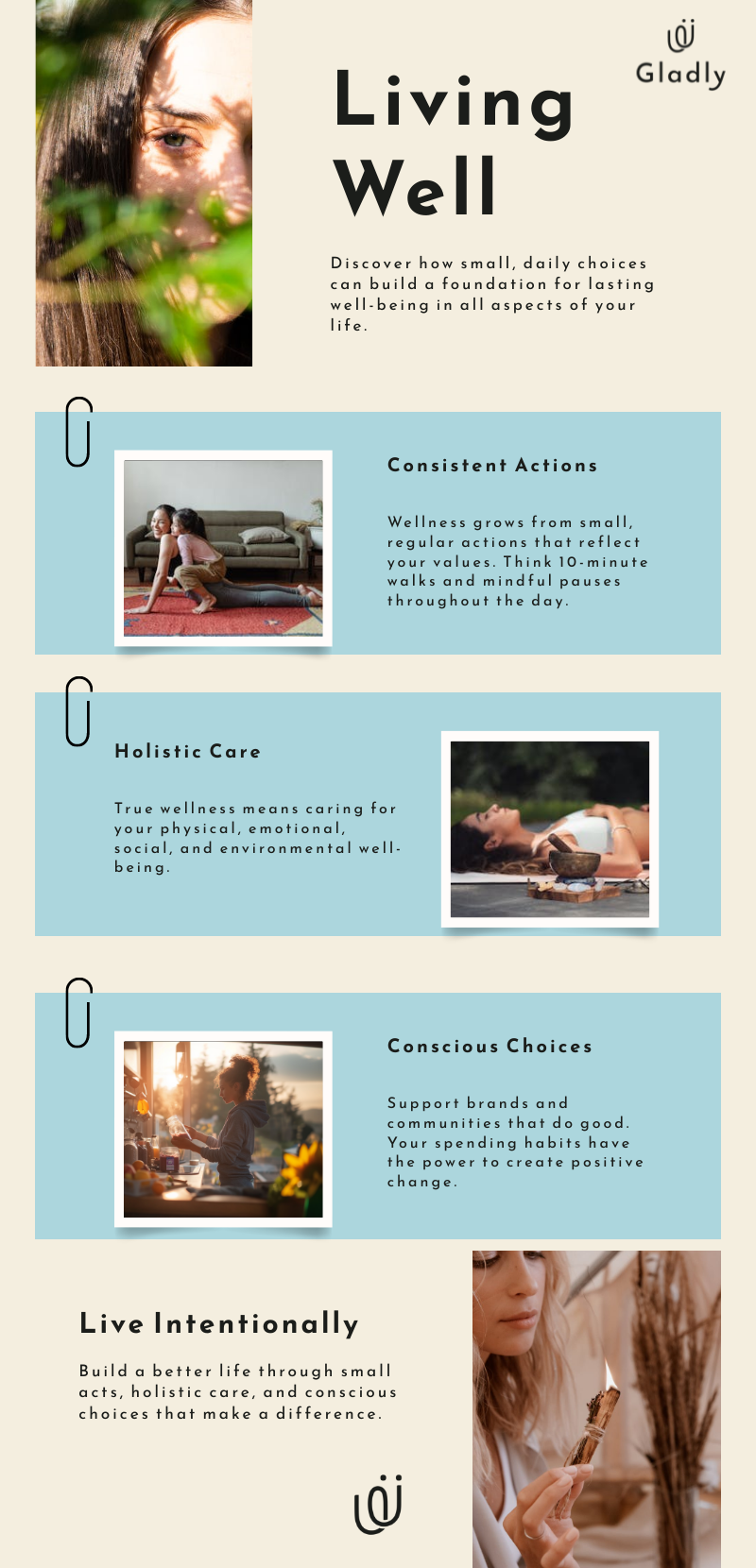Wellness has more impact when it fits into real life. At Gladly Network, we see it as something you build over time, not something you chase.
This post shares practical ways to support your physical, mental, and social well-being with habits that feel doable and kind. If you’re working toward a more balanced lifestyle, these ideas are a good place to start.
How to Boost Your Physical Wellness
Physical wellness forms the foundation of a balanced lifestyle. Small changes in physical habits can lead to significant improvements in overall well-being. Let’s explore some practical strategies to enhance your physical wellness.
Tailor Exercise to Your Fitness Level
Regular physical activity maintains good health. The World Health Organization recommends at least 150 minutes of moderate-intensity physical activity throughout the week, or at least 75 minutes of vigorous-intensity physical activity. However, you don’t need to jump into intense workouts right away. Start where you are.
If you’re new to exercise, begin with brisk walking for 10 minutes a day. Gradually increase the duration and intensity as your fitness improves. For those with a moderate fitness level, try alternating between cardio and strength training. High-intensity interval training (HIIT) can burn calories efficiently in shorter time spans for more advanced fitness enthusiasts.
As your routine becomes more consistent, you may also want to support recovery and muscle health through nutrition. For those adding strength training or HIIT into their week, clean-label options like NiTOR‘s protein powders can offer a performance boost without the fillers you’ll find in many mainstream supplements.
Consistency is key. Choose activities you enjoy to make exercise a sustainable habit. Whether it’s swimming, cycling, or dancing, find what works for you.

Nourish Your Body with Balanced Nutrition
A balanced diet is essential for physical wellness. Proper nutrition helps keep energy levels up and protects against many age-related illnesses and diseases like heart disease, cancer, and diabetes.
Start by filling half your plate with colorful fruits and vegetables at each meal. This ensures you’re getting a wide range of vitamins and minerals. Include whole grains (like quinoa or brown rice) for sustained energy, and lean proteins (such as fish, poultry, or plant-based options) for muscle health.
Set aside time each week to plan your meals, focusing on variety and nutrition. This not only ensures you’re eating well but can also save time and reduce stress during busy weekdays. Keeping clean-label staples on hand, like Aloha’s plant-based protein bars or powders, can help fill the gaps when life gets busy without compromising on quality.
Prioritize Quality Sleep for Optimal Health
Sleep is often overlooked in wellness discussions, but it’s vital for physical health. The National Sleep Foundation recommends 7-9 hours of sleep per night for adults.
To improve sleep quality, establish a consistent sleep schedule. Go to bed and wake up at the same time every day (even on weekends). Create a relaxing bedtime routine, such as reading a book or practicing gentle stretches.
Limit screen time before bed, as the blue light emitted by devices can interfere with your sleep-wake cycle. Instead, try using this time for mindfulness practices or gentle yoga, which can help calm your mind and prepare your body for rest.
Creating a relaxing bedtime environment can also support deeper rest. Soothing accessories like slightly weighted garments from Comfrt are designed to promote calm and comfort, helping you wind down naturally at the end of a busy day.
Create a Holistic Approach to Physical Wellness
Physical wellness is interconnected with other aspects of your life. Try to integrate physical wellness practices into your daily routine. For example, you might take a walk during your lunch break (combining exercise with stress relief) or prepare nutritious meals with friends (combining healthy eating with social connection).
As you focus on these pillars of physical wellness – exercise, nutrition, and sleep – you’ll lay a strong foundation for overall health and well-being. Small, consistent changes often lead to the most sustainable results. Start with one area and gradually incorporate others as you build your wellness-centered lifestyle.
Now that we’ve covered physical wellness, let’s turn our attention to an equally important aspect of a balanced lifestyle: mental and emotional wellness. These elements play a significant role in our overall health and can greatly impact our physical well-being as well.
Nurturing Mental and Emotional Health
Mental and emotional wellness form essential components of a balanced lifestyle. We understand the importance of cultivating inner peace and resilience. Here are practical strategies to enhance your mental and emotional well-being.
Practice Mindfulness Daily
Mindfulness is a powerful tool for mental health. Mindfulness-based stress reduction (MBSR) has been shown to be effective in reducing anxiety, depression, and stress among healthcare professionals. Start small by dedicating five minutes each day to mindful breathing. Focus on your breath, notice the sensation of air entering and leaving your body. This simple practice can improve your overall well-being.
For a more structured approach, try popular meditation apps. They offer guided meditations tailored to various needs, from stress relief to better sleep.

Implement Effective Stress Management
Stress is unavoidable, but how we handle it makes all the difference. One effective strategy is the 4-7-8 breathing technique. Inhale for 4 seconds, hold for 7, and exhale for 8. This method activates the parasympathetic nervous system, which promotes relaxation.
For a more structured and personalized experience, platforms like ImpactSuite offer guided meditations, self-check-ins, and professional coaching that align with your wellness journey. Their holistic tools make it easier to turn daily habits into meaningful change, whether you’re managing stress, improving sleep, or building emotional resilience
Another powerful tool is journaling. Spend 10 minutes each evening writing down your thoughts and feelings. Journaling can help manage anxiety, reduce stress, and cope with depression.
Strengthen Emotional Resilience
Emotional resilience grows stronger with practice (like a muscle). Start by challenging negative self-talk. When you catch yourself thinking negatively, pause and ask: “Is this thought helpful? Is it true?” This simple practice can shift your perspective and boost emotional well-being.
Gratitude interventions have been shown to be effective in improving workers’ mental health and well-being. Each night, write down three things you’re grateful for. This practice can increase happiness and life satisfaction.
Foster Social Connections
Social connections are vital for mental health. Make an effort to reach out to a friend or family member daily, even if it’s just a quick text or call. Strong relationships are important for happiness and longevity.
Try joining a local community group or volunteering. These activities not only benefit others but also boost your own mental health. Engaging in acts of kindness can significantly improve your mood and sense of purpose.
As you incorporate these practices into your daily routine, you’ll notice improvements in your mental and emotional wellness. Small, consistent actions often lead to the most significant changes. Celebrate micro-wins and take regular water breaks to support your energy and focus throughout the day. Now, let’s explore how social and environmental factors contribute to our overall well-being.
Enhancing Social and Environmental Wellness
Strengthen Your Social Connections
Social wellness forms a key pillar of overall well-being. Schedule regular catch-ups with friends and family. A 15-minute video call can boost your mood and sense of connection. Studies generally tend to agree that people report greater experiential well-being when with their friends and family, as opposed to when they are alone.
For remote workers, set up virtual coffee breaks with colleagues. This informal interaction helps maintain workplace relationships and fights isolation. Many companies report increased team cohesion and productivity after implementing such practices.
Give Back to Your Community
Volunteering enhances both social and environmental wellness. People who volunteer monthly are 7% more likely to report feeling “very happy” compared to those who never volunteer (London School of Economics research).
Find local opportunities that match your interests. Help at a food bank, participate in a beach clean-up, or mentor youth. Your contribution makes a difference. Random acts of kindness can also significantly improve mental health and foster stronger social connections.
Through the #getgladly initiative, you can share the story of someone in your community who makes a quiet difference, whether it’s a neighbor who checks in on others, a coworker who leads with compassion, or a local volunteer who inspires change. It’s a way to recognize everyday acts of kindness and remind us that doing good starts close to home.

Create Positive Spaces
Your immediate environment impacts your well-being significantly. Start by decluttering your home or workspace. A cluttered environment can make it more difficult to focus and process information.
Add plants to your living and working spaces. However, it’s important to note that potted plants do not improve indoor air quality, according to a review and analysis of reported VOC removal efficiencies. Try spider plants, peace lilies, or snake plants for their aesthetic appeal.
Consider how color affects your mood. Blue can promote calmness, while yellow can boost energy and creativity (color psychology). Experiment with different colors in your home or office to find what works best for you.
Foster Environmental Awareness
Develop eco-friendly habits to boost your environmental wellness. Try reducing single-use plastics, composting organic waste, or using public transportation more often. These small actions can lead to a sense of purpose and connection with the environment.
Participate in local environmental initiatives (such as community gardens or recycling programs). These activities not only benefit the planet but also provide opportunities for social interaction and personal growth. Consider exploring ethical clothing options to align your values with your consumer choices.
Practice Digital Wellness
In our interconnected world, digital wellness plays a role in both social and environmental health. Set boundaries for technology use to prevent digital overwhelm. Try a “digital sunset” an hour before bedtime to improve sleep quality and reduce stress.
Use technology mindfully to enhance social connections without replacing face-to-face interactions. Balance screen time with outdoor activities to maintain a connection with nature and improve overall well-being.
Living Well, Little by Little
Wellness is shaped by the choices we make each day, how we nourish our bodies, how we move, who we connect with, and even the brands we choose to support. Those choices carry weight.

At Gladly Network, you’ll find thoughtful perks from brands that align with your values, products that feel good to use, and do good in the world. Registration is free, and exploring those options is a simple step toward more intentional living.
Let wellness be something you grow into, choice by choice.











